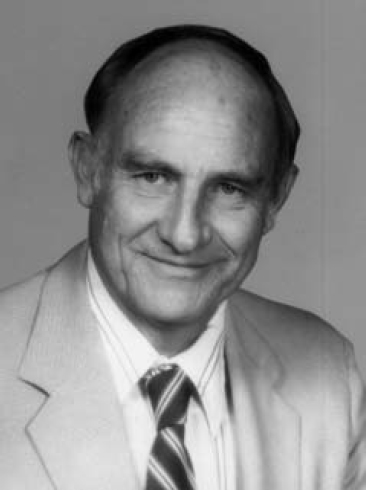
1930–2000
Elected in 1993
“For technical and managerial leadership in material models and tools for numerical simulation of nonlinear dynamic phenomena.”
BY ORVAL E. JONES SUBMITTED BY THE NAE HOME SECRETARY
WALTER HERRMANN was born on May 2, 1930, in Johannesburg, South Africa. He was the only child born to Gottlob Fredrich Herrmann, a hotel proprietor, and Gertrud Louise Herrmann (nee Ratzlaff). Herrmann received both his undergraduate (1953) and Ph.D. (1955) degrees in mechanical engineering from Witwatersrand University in South Africa. Dr. Hermann then taught mechanical engineering at the University of Cape Town for two years until 1957, when he was invited by the Massachusetts Institute of Technology (MIT) to work as a researcher in the Cold War effort.
He married Betty Lorraine Allard in 1955. They raised two children, a daughter, Inga, and a son, Peter, before divorcing in 1983. In 1988, Dr. Herrmann married Ednarae Bligh Gross, who preceded him in death in 1996. Dr. Herrmann was an accomplished skier, a mountaineer (he volunteered for many years for mountain rescues in New Mexico), and a cyclist. He also enjoyed river rafting and scuba diving. After retiring from Sandia National Laboratories, he was a volunteer for the New Mexico Museum of Natural History and served as a docent at archeological sites in southern Colorado. Throughout his life Dr. Herrmann was an avid traveler, and in his later years he developed a passion for tall ships, sailing, and archeology.
Walter Herrmann came to Sandia National Laboratories via the MIT Division of Sponsored Research, where he was developing his WAVE 1 finite-difference computer program for numerically calculating high-amplitude, nonlinear wave propagation in one-dimensional structures. Sandians C. Donald Lundergan and Charles F. Bild, then the director of materials and process development, along with others, recognized that computers were becoming powerful enough to realistically simulate shock-wave deformation of structures. Such deformation results from the detonation of explosives or high-velocity impact. Indeed, they were proven right; Herrmann was successful in building this capability at Sandia. During the Cold War between the United States and former Soviet Union, such capability was urgently needed for the development of new nuclear weapons.
Herrmann joined Sandia in early 1964 as supervisor of the Deformation of Structures Division. Initially, he had no staff, but he had management support to build a computer-code development team. WAVE 1 became the basis for the Sandia WONDY finite-difference computer program, which was soon used in nuclear weapons component development. Next, the Sandia TOODY computer program was developed, which enabled two-dimensional simulation and analyses of structures. Some of the important code developers included Herrmann (a formidable mathematician and computer scientist), Larry D. Bertholf, Darrell L. Hicks, R. Jeffry Lawrence, Samuel L. Thompson, Billy J. Thorne, and Robert J. Walsh. Thompson went on to develop a powerful three-dimensional code that included radiation transport.
These computer programs all required knowledge of nonlinear constitutive behavior of materials at the extreme stresses and strain rates induced by shock-wave loading. Building on Lundergan’s program of projectile plate impacts, along with data from other Sandia organizations and other laboratories, the experimental data for developing constitutive models of many types of materials—metals, ceramics, polymers, composites, foams, for example—were obtained. Names of some of the key staff members engaged in this
activity during the next 25 years included James R. Asay, Lynn M. Barker (inventor of the VISAR), Barry M. Butcher, Lalit C. Chhabildas, Robert A. Graham, Charles H. Karnes, Darrell E. Munson, and Karl W. Schuler. The experimental data then had to be incorporated into theoretical constitutive models in order to be used in the computer programs that were under development. Some of the key researchers in this activity included Albert J. Chabai, Peter J. Chen, Lee W. Davison, Douglas S. Drumheller, Dennis B. Hayes, Herrmann, James N. Johnson, Orval E. Jones, and Jace W. Nunziato. Many of these individuals and others were also involved in code simulations applied to pressing national problems. A particularly notable example is the work of Paul Yarrington on missile impact and cratering and warhead contact fusing. Other such contributors included Marlin E. Kipp and Timothy J. Trucano.
Over a period of more than 25 years Herrmann recruited, managed, directed, and led by example an extremely productive and internationally known organization of some 45 to 50 scientists and technicians. In 1982 he was appointed director of engineering sciences—an organization of some 140 technical staff—that, in addition to the aforementioned solid dynamics activities, included general engineering structural analysis and fluid and thermal sciences. In 1992, prior to his retirement in 1993, he was named a Sandia Senior Fellow.
Herrmann died on June 4, 2000, at the age of 71.
Survivors include his children, Inga and Peter, and stepsons, Allan and Jeffrey Gross, all of Albuquerque; a stepdaughter, Janis Gross of Longmont, Colorado; grandchildren Rishar, Mariah, and Joshua; and his former wife, Betty Lorraine Allard Herrmann, of Albuquerque.




